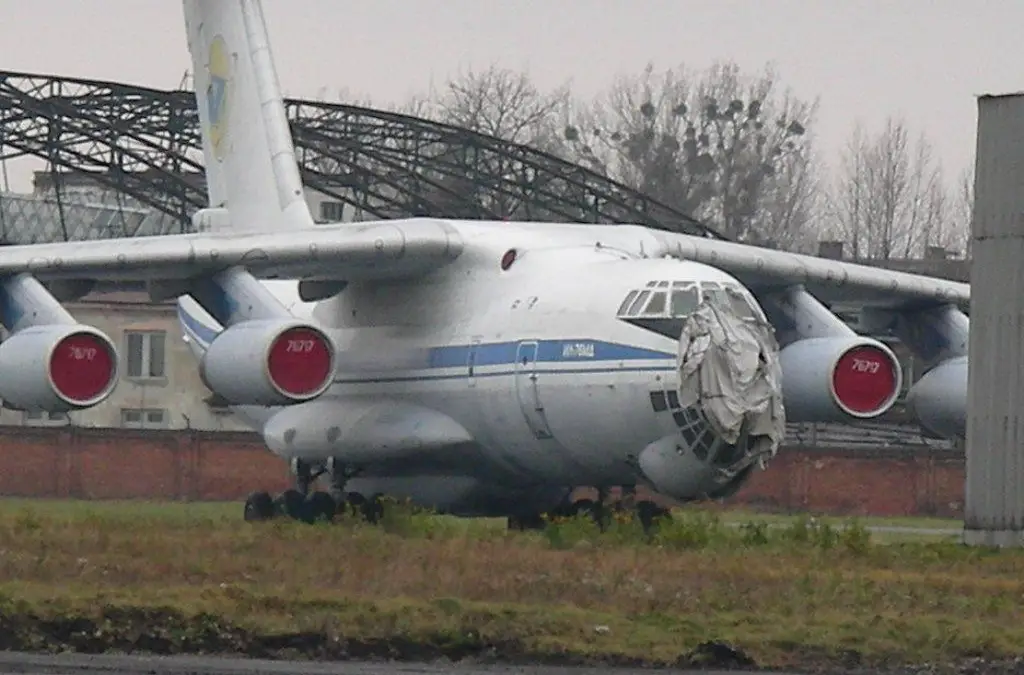
The Boeing 777 began its manufacturing run in 1993, and is still being made today. With freight and passenger variants, this long-range commercial jetliner is the world’s largest and longest twin-engine commercial aircraft. According to Boeing, 1,767 have been delivered as of August 2025, and in 2023, 777 family aircraft were the third-most common airliner in the world, according to Jalopnik, and also the most popular widebody jet on the commercial market.
The 777 is one of the largest jetliners in the world, and among Boeing commercial aircraft, only the 747 is larger. Meanwhile, another aircraft that commonly features among the largest aircraft in the world is the Ilyushin Il-76, a Soviet-era long-range transport aircraft that has seen extensive use as a commercial freighter, particularly for ramp-delivered cargo. According to Air Charter Service, the Il-76 is the most popular cargo aircraft in the history of air transportation, but between it and the 777, which of these two behemoths is bigger?
Dimensions Of The Largest Il-76 and 777 Variants
A list consisting of the 13 biggest planes in the world was featured on Popular Mechanics in 2023, and both the 777-9 and Il-76 featured on it. As aircraft on the list were listed in no particular order, and several different metrics were used to describe the size of each aircraft, it is not ideal for determining which is bigger. Therefore, the specifications and dimensions of the two aircraft are listed below:
Data from Boeing, JETVIP, Volga Dnepr.
The largest variation of the 777 currently on the market, until the 777-9 is finally released, is the 777-300ER. The ‘ER’ stands for ‘Extended Range’, and the variant has a higher maximum takeoff weight (MTOW) and increased fuel capacity, increasing the range of the aircraft. Aerodynamic refinements to the 777-300, including new extended raked wingtips, have also given the -300ER a fuel burn reduction of 1.4%, according to Flight Global.
There were only two of the largest variants of the Il-76 built, called the Il-76MF. These were stretched military versions, with a 22-foot-longer fuselage, PS-90A-76 engines, a heavier maximum takeoff weight of 460,000 pounds, and a lift capability of 130,000 pounds. The variant first flew in 1995, and both were delivered to the Royal Jordanian Air Force, later being sold to the Egyptian Air Force.
The Aircraft Compared
From the specifications above, there are some large differences between the 777 and Il-76, especially in areas relating to their size and performance characteristics. It should be noted that the freight variant of the 777, the 777F, is based on the 777-200LR Worldliner, the ‘LR’ standing for ‘Long Range’. This variant was named Worldliner as it can connect almost any two airports in the world, and is differentiated from older ‘ER’ variants, according to FlightGlobal. The 777F shares its dimensions with the -200LR, being smaller than the largest -300ER.
When put next to each other, the size differences between the 777-300ER and Il-76 make it obvious that they are different classes of aircraft, made for very different purposes. Comparing the MTOW and the payload that the 777F and Il-76 can carry, both are proportionally similar. Considering that the Il-76 is a quadjet designed specifically to carry heavy loads, it demonstrates the significant advancements in technology, where a converted airliner can carry a similar load in proportion to its weight.
The Il-76 was designed as a quadjet for good reason, as more engines mean more thrust, and thus more lifting capacity. However, the downside of this is reduced capacity over long distances, and the shorter range of the Il-76 shows that. The Il-76 is an old family of aircraft, with many variations, being manufactured from 1971 to the present. As seen above, Russia has recently invested $584 million to boost IL-76 production from 7 to 24 units annually, aiming for civilian certification and exporting to countries like India, Iran, and Egypt.
Where the Il-76 Excels
With 975 examples having been built, according to RussianPlanes, the Il-76 has been successful enough to justify a ramping up of production because of its wide range of applications. Variations of the aircraft are used for aerial refueling, and as seen above, some are used for firefighting, as water bombers. The Il-76 is capable of carrying 13,000 US gallons of water for this application, which is more than three times the capacity of the C-130 Hercules. Speaking of which, whales were once transported in an Il-76.
However, where the Il-76 shines is when loading bulky and heavy cargoes safely and efficiently, which it achieves via its rear ramp and long upper tail doors.
Volga Dnepr is a cargo company that owns at least five Il-76 aircraft, and the company’s fact sheet specifies more of the equipment onboard, which assists crews in loading and maneuvering such loads:
“The freight compartment of the IL-76TD-90VD is equipped with two electric winches, each with a three-tonne hauling capacity. There are four electric hoists with 10-tonne total lifting capacity, which move on two rails along the entire length of the cargo compartment and six meters beyond the ramp threshold. It is possible to load through the cargo door into the main deck of the aircraft directly from the ground or from a truck. Volga-Dnepr’s specialist loading equipment allows a single piece of cargo weighing up to 50 tonnes to be carried on board.”
The Il-76 is equipped to operate at airports with little or no loading support devices, as it was developed to deliver heavy machinery to remote and poorly served areas. Thanks to its ability to operate on rough, unpaved runways, it has been a useful aircraft for serving undeveloped areas. It has been used as an emergency response transport for civilian evacuations, and provided humanitarian aid and disaster relief around the world. Thanks to its spacious cargo compartment, it has also been used for reduced-gravity training of occupants.
The 777’s Cabin Size Improves Passenger Comfort
For military troop transportation purposes, the Il-76 was fitted with hard benches, making it not ideal in terms of passenger comfort. However, the 777 has flexible options for passenger transport in terms of layout and spaciousness, thanks to its wide cabin. According to Boeing, airlines purchasing the 777 can count on the following density when planning configurations:
Boeing claims that the 777 is the most comfortable aircraft in its class, with an internal cabin width of 231.1 when outfitted in a passenger configuration. In a two-class configuration, the 777 is capable of serving very dense routes for medium-to-long haul travel. As an example, the 777-300ER can carry 451 passengers, with 40 first class and 411 premium economy seats.
Both The 777 And Il-76 May Be Seeing More Use
In recent years, some airlines have been bringing slightly older, high-capacity widebody aircraft, such as the Airbus A380, back into service. This has been necessary to serve the fast-increasing passenger demand seen since the bounce back of the aviation industry following the COVID shutdowns. Some airlines have also deferred planned retirements of such planes, squeezing more years of life out of older models. Given the current state of the commercial passenger aviation industry, demand for the 777 is likely to remain high for serving hub-to-hub routes.
In the case of the Il-76, the aircraft is so versatile in its applications that it will remain in demand for military transport purposes, but also by freight companies and aid/logistics organizations. The aircraft will be well-suited to the target European, African, and Middle Eastern countries it is planned to be exported to, being capable of dealing with the rough terrain. Even though both these aircraft are very different in size and application, it is good to know that both aircraft will be utilized for some time to come.



